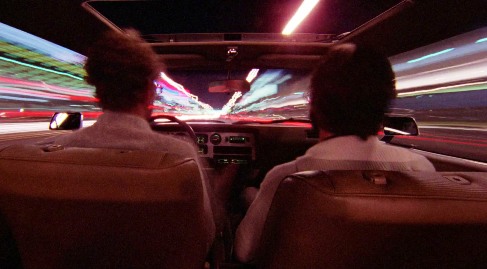 Three films by Godfrey Reggio and Philip Glass present wordless imagery and music to send a cosmic warning about civilization’s imbalance, exploitation, and destruction.
Three films by Godfrey Reggio and Philip Glass present wordless imagery and music to send a cosmic warning about civilization’s imbalance, exploitation, and destruction.
The meanings that we access through works of art are not confined to the conscious intentions of the artists. This critical truth came to mind while watching The Qatsi Trilogy—three films directed by Godfrey Reggio, and scored by Philip Glass.
These are films without any talking, just imagery and music. The only text comes at the end, when the odd-sounding film titles are explained. Philip Glass’s music is an essential component. It’s not the usual situation where the music accompanies a narrative, or helps illustrate it. The music is united to the visuals as if they were one thing. I know people who are maddened by Glass’s music, which is characterized by a lot of repetition. But here it aligns the viewer’s attention and emotions with the images. The repetitive motifs help the mind let go of the scattered, wandering forms of attention that can be habitual for us.
Koyaanisqatsi, from 1982, starts with shots of nature in awe-inspiring aspects: mountains, canyons, deserts, and so on, with human beings conspicuously absent. Eventually we shift to footage of modern civilization, and in comparison to nature these images seem bizarre and outlandish. Two techniques comprise most of the film: slow motion and fast motion. The fast motion is actually time-lapse photography: footage of events that take hours or even days appearing to take place in just minutes. The movement of vehicles, traffic zipping through huge highway systems, masses of people, colossal buildings in major cities and the traffic within those cities: time-lapse photography takes away the familiarity of these things and makes them seem alien. In purely visual terms, the images are astounding, weird, beautiful, yet disturbing. Slow motion is used when we are looking at things more close up, especially people. Watching the movement of a crowd in slow motion, the familiar is once again supplanted by the sensation of strangeness. These beings, in the way they move, the way they avoid each other’s gaze, evoke questions and doubts about human nature, our striving and seeking, our ignorance and mortality.
Powaqqatsi, from 1988, refrains from time-lapse photography, but it still uses a lot of slow motion. Here the footage is from the lands of non-European people. First we see traditional forms of work such as planting. Then civilization shows up. Instead of fairly well-dressed folks we see a much poorer populace. Modernity has conquered this non-white world, but it hasn’t helped the people. Here’s the theme of injustice and exploitation, and one’s heart hurts more watching this than it did during the more alienated first film.
Naqoyqatsi was released in 2002, after a gap of thirteen years. Why this long delay I don’t know. The film uses graphics, animation, and  rotoscope photography to visualize the mind realm, the world of thinking and science. The mathematical and geometric designs become like a relentless drum beat of “progress.” Eventually the rhythm becomes the marching of soldiers, the creation of weapons, guns firing and the detonation of bombs. It shows the cleverness of humans serving the expansion of war.
rotoscope photography to visualize the mind realm, the world of thinking and science. The mathematical and geometric designs become like a relentless drum beat of “progress.” Eventually the rhythm becomes the marching of soldiers, the creation of weapons, guns firing and the detonation of bombs. It shows the cleverness of humans serving the expansion of war.
One thing that makes The Qatsi Trilogy difficult is that it seeks to evoke the impersonal as the source of meaning in the modern world. This allows us to recognize a certain kind of insanity in civilization. We are offered a different way of seeing and hearing.

Michael Powell’s 1948 drama, about a ballerina torn between love and career, is possibly the most visually beautiful ever made. If one were asked...

A man is mistaken for a contract killer, and the ensuing disaster is ripe for dark comedy. Mayhem can be fun. In a movie,...

The Brutalist is not about brutalist architecture or the school that created it. Yes, the main character is an architect, and his work appears...